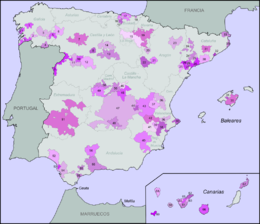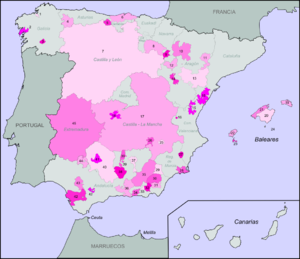- Spanish wine regions
-
The mainstream quality wine regions in Spain are referred to as Denominaciones de Origen (similar to the French Appellations) and the wine they produce is regulated for quality according to specific laws.
In compliance with European Commission Regulation (CE) 753/2002, Spanish wines are classified into two categories, which in turn are further classified into sub-categories depending on the strictness of the criteria applied in producing the type of wine in question:[1]
- Quality Wines Produced in a Specified Region (QWPSR)
- (Vino de Calidad Producido en Región Determinada (VCPRD) in Spanish)
- Denominación de Origen de Pago (DO de Pago): these wine regions aspire to the very highest standards with extremely strict geographical criteria, centering on individual single-estates with an international reputation. There are currently only 10 estates with this status: 7 in Castile-La Mancha, 3 in Navarre and 1 in Valencia.
- Denominación de Origen Calificada (DOCa) (Denominació d'Origen Qualificada (DOQ) in Catalan): regions with a proven track record of consistent quality. There are only 2 wine regions with this status: Rioja and Priorat.
- Denominación de Origen (DO) (Denominació d'Origen in Catalan, Denominación de Orixe in Galician and Jatorrizko Deitura in Basque): mainstream quality-wine regions. There are 66 wine regions with this status.
- Vino de Calidad con Indicación Geográfica. A 'starter home' for wine regions climbing the quality ladder. There are 2 wine regions with this status.
- Table Wine (Vino de Mesa in Spanish)
-
- Vino de la Tierra (VdlT) "Country wines" which do not have EU QWPSR status but which may use a regional name. There are currently 46 Vino de la Tierra regions in Spain.
- Vino de Mesa (Table Wine) is bulk-grown, usually drawn from a wide variety of regions and hence has no vintage or area designation on the label, apart from "Produce of Spain". Production of this low grade of Spanish wine is falling year on year.
In 2006 a new Vino de la Tierra "super-region" was created called Viñedos de España (not listed below) which is permitted to blend wines from 11 different Spanish regions. This has yet to be ratified by the EU, however, and has been legally challenged by the regional governments of La Rioja and Castile and León.[2]
Although almost all wine regions are confined to specific centres of production, some of the top denominaciones (Cava and Rioja in particular) are the product of more than one Autonomous Community. This is in contrast to Denominaciónes de Origen de Pago, where the location criteria are very strict indeed, often centering on specific plots of land and admitting only those wines produced in their immediate vicinity.[3]
List of Spanish Denominaciones de Origen and Vinos de la Tierra by Community
Autonomous
CommunityDominiaciónes de Origen (DO)
(DOCa and DO de Pago in bold)Vinos de la Tierra (VdlT)
(VCPRD in bold)Andalusia Condado de Huelva
Jerez-Xeres-Sherry
Málaga
Manzanilla Sanlúcar de Barrameda
Montilla-Moriles
Sierras de MálagaBailén
Cádiz
Contraviesa-Alpujarra
Córdoba
Desierto de Almería
Granada Sur-Oeste
Laujar-Alpujarra
Los Palacios
Norte de Almería
Norte de Granada
Ribera del Andarax
Sierra Norte de Sevilla
Sierra Sur de Jaén
Sierras de Las Estancias y Los Filabres
Torreperogil
Villaviciosa de CórdobaAragon Bajo Aragón
Ribera del Gállego-Cinco Villas
Ribera del Jiloca
Ribera del Queiles
Valdejalón
Valle del CincaAsturias (none) Cangas Cantabria (none) Costa de Cantabria
LiébanaCastile and León Arlanza
Arribes
Bierzo
Cigales
Ribera del Duero
Rueda
Tierra de León
Tierra del Vino de Zamora
Toro
Cava (one producer in Aranda de Duero)Castilla y León
Valles de Benavente (Vino de Calidad)
Valtiendas (Vino de Calidad)Castile-La Mancha Almansa
Campo de La Guardia (DO de Pago)
Dehesa del Carrizal (DO de Pago)
Dominio de Valdepusa (DO de Pago)
Finca Élez (DO de Pago)
Guijoso (DO de Pago)
Pago Casa Del Blanco (DO de Pago)
Jumilla
La Mancha
Manchuela
Méntrida
Mondéjar
Pago Florentino (DO de Pago)
Ribera del Júcar
Uclés
ValdepeñasCastilla
Gálvez
Pozohondo
Sierra de AlcarazCatalonia Alella
Catalunya
Conca de Barberà
Costers del Segre
Empordà
Montsant
Penedès
Pla de Bages
Priorat (DOCa)
Tarragona
Terra Alta
Cava(none) Community of Madrid Vinos de Madrid (none) Valencian Community Castelló
El TerrerazoExtremadura Extremadura Galicia Monterrei
Rías Baixas
Ribeira Sacra
Ribeiro
ValdeorrasBarbanza e Iria
Betanzos
Valle del Miño-OrenseBalearic Islands Formentera
Ibiza
Illes Balears
Mallorca
Isla de Menorca
Serra de Tramuntana-Costa NordCanary Islands[4][5] Abona
El Hierro
Gran Canaria
La Gomera
La Palma
Lanzarote
Tacoronte-Acentejo
Valle de Güímar
Valle de la Orotava
Ycoden-Daute-Isora(none) Foral Community of Navarre Navarra
Señorío de Arínzano (DO de Pago)[6]
Prado de Irache (DO de Pago)
Otazu (DO de Pago)
Rioja
CavaRibera del Queiles Basque Country Txacolí de Bizcaia
Txacolí de Getaria
Txacolí de Álava
Rioja (Alavesa)
Cava(none) Murcia Alicante
Bullas
Jumilla
YeclaAbanilla
Campo de CartagenaLa Rioja Rioja (DOCa)
CavaValles de Sadacia References
- ^ BOE No.165 dated 11 de julio de 2003 (ed.): «Ley 24/2003 de la Viña y del Vino
- ^ [Denominaciones de Origen e Indicaciones Geográficas] - Food - M.A.P.A
- ^ [Denominaciones de Origen e Indicaciones Geográficas] - Food - M.A.P.A
- ^ www.turismodecanarias.com Canary Islands
- ^ http://www.gobiernodecanarias.org
- ^ Hughes, Natasha, Decanter.com. "Julian Chivite bodega gets top classification". http://www.decanter.com/news/172731.html.
Spanish wine regions Major regions 
Denominación
de Origen (DO)Calatayud • Campo de Borja • Cariñena • Somontano • Cava
Abona • El Hierro • Gran Canaria • La Gomera • La Palma • Tacoronte-Acentejo • Valle de Güímar • Valle de la Orotava • Ycoden-Daute-IsoraArlanza • Arribes • Bierzo • Cigales • Ribera del Duero • Rueda • Tierra de León • Tierra del Vino de Zamora • Toro • CavaAlmansa • Dehesa del Carrizal • Dominio de Valdepusa • Finca Élez • Guijoso • Jumilla • La Mancha • Manchuela • Méntrida • Mondéjar • Ribera del Júcar • Uclés (DO) • ValdepeñasAlella • Catalunya • Conca de Barberà • Costers del Segre • Empordà • Montsant • Penedès • Pla de Bages • Priorat • Tarragona • Terra Alta • CavaRibera del Guadiana • CavaCategories:- Spanish wine
- Wine regions of Spain
- Wine-related lists
- Appellations
Wikimedia Foundation. 2010.


